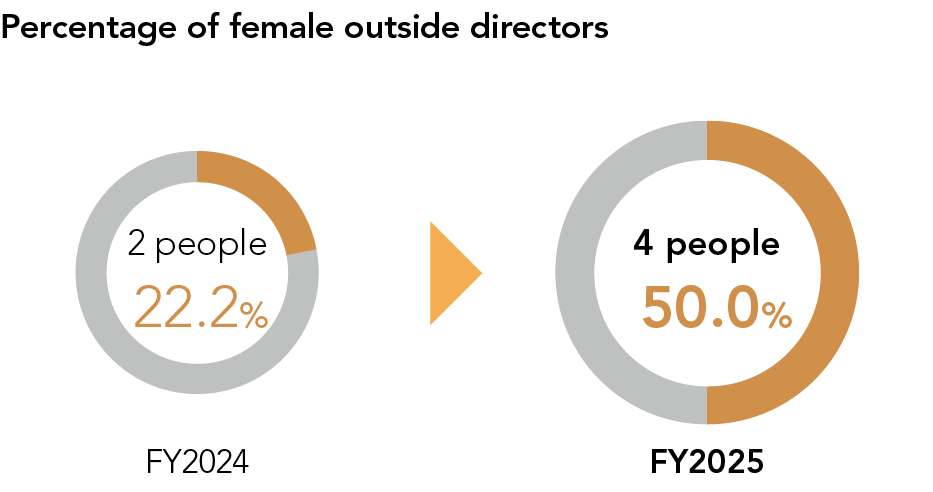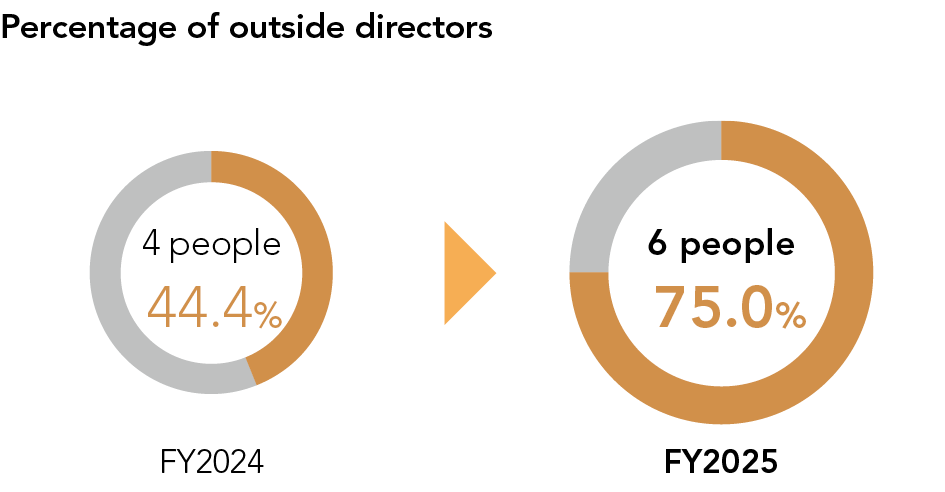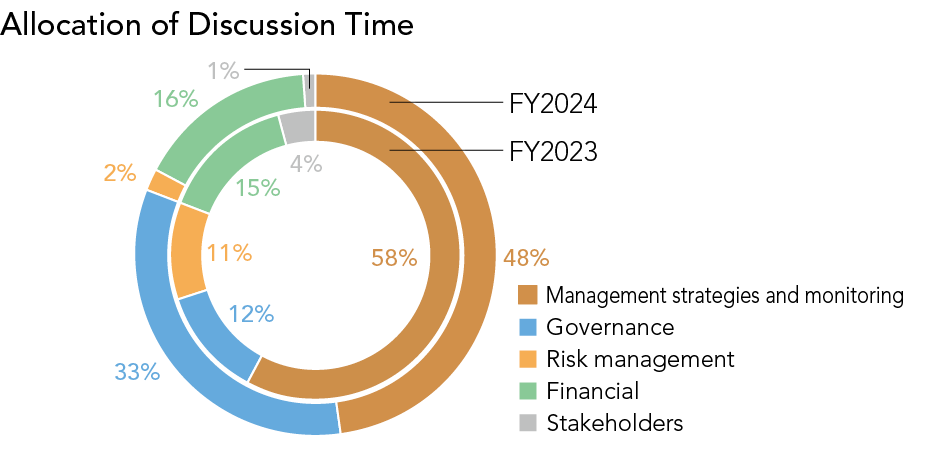As the highest decision-making management body (meeting at least once per month as a general rule), the Board of Directors makes decisions on important management issues, such as the medium- to long-term management policies and business strategies, that help create social value and corporate value.
Additionally, as per the Board of Directors Regulations, the Board supervises directors and executive officers selected by the Board of Directors in the performance of their job duties.
Of the eight directors, six are independent outside directors (75.0%) and four are female directors (50.0%). There are three directors who are Audit and Supervisory Committee members, three of them being independent outside directors (100.0%), and two being women (66.7%). (See p. 54 for more on skill diversity.)


- Policies towards achieving management that is conscious of cost of capital and stock price
- Progress of medium- to long-term management strategies and medium-term management plan
- Direction of capital policy
- Share price and IR activity direction
- Effectiveness of the Board of Directors
- Changing the company name to Joshin Corporation
- Transitioned to a company with an Audit and Supervisory Committee
Post-transition Board of Directors and Audit and Supervisory Committee structures (number of members, composition, skills, etc.) Post-transition roles of directors Items to be discussed in the post-transition Board of Directors Alongside changes to the organizational structure, revisions to Articles of Incorporation, Board of Directors Regulations, and other important rules and regulations pertaining to management delegation
- Formulated the FY2025 (78th) Management Plan
- Implemented the stock incentive system for employees

The Audit and Supervisory Committee is comprised of three directors who are Audit and Supervisory Committee members. All of them are independent outside directors. In general, they meet once per month. The outside directors who are Audit and Supervisory Committee members share information and exchange opinions on the directors’ performance of their duties, in addition to timely monitoring of actual management status by reviewing important approval documents and other materials. They also monitor the decision-making process by exchanging information with the Audit Department (internal audit division) and Accounting Auditors, and audit the directors’ execution of their duties. The outside directors who are Audit and Supervisory Committee members elected a Certified Public Accountant with deep accounting knowledge and experience as well as an attorney with deep legal knowledge and experience in order to bolster the auditing and supervisory functions of the Audit and Supervisory Committee.
Joshin established the Nomination and Compensation Committee as an advisory body to the Board of Directors, in order to strengthen corporate governance by ensuring the independence, objectivity, and transparency of the Board of Directors. To ensure independence, this committee is comprised of three independent outside directors and the Chairman and Representative Director.
Outside directors comprise three-fourths of the committee in addition to occupying the Head of Committee position. This committee discusses HR issues including the appointment and dismissal of the representative director and other directors as well as CEO successor planning. It also discusses director (excluding Audit and Supervisory Committee members) remuneration system design and individual compensation amounts. These discussions produce recommendations that are then submitted to the Board of Directors for a decision.
The Board of Directors Evaluation Committee consists of six independent outside directors, and was established as an advisory body to the Board of Directors to analyze and evaluate the effectiveness of the Board of Directors and continuously improve its effectiveness. This advisory body is part of overall initiatives to strengthen corporate governance, while aiming to achieve sustainable growth and increase medium- to long-term corporate value. By evaluating the effectiveness of the Board of Directors, the independent outside directors provide appropriate advice to the Board of Directors from a variety of angles and perspectives.
The Board of Executive Officers (which generally meets every other week) is the central body for business execution, consisting of executive directors and executive officers. It is established to formulate the management strategies of the Board of Directors, improve the supervisory functions, and speed up the decisionmaking process for business execution. In June 2025, during the change in organizational structure wherein the Company transitioned into a company with an Audit and Supervisory Committee, we also largely transferred the Board of Directors’ authority over business execution decisions to the Board of Executive Officers with the aim of further accelerating the speed of decision-making. Independent outside directors participate as observers in order to contribute to the evaluation and training of candidates for CEO and director positions.
Chaired by the Director, President and Executive Officer, the Sustainability Committee is comprised of executive directors, executive officers, directors who are full-time members of the Audit and Supervisory Committee, and heads of departments. This committee works to achieve our management philosophy and our management vision by managing the seven material issues and 14 action items, together with the progress of important divisionspanning internal projects that support this work. The Committee centrally manages financial and nonfinancial information for our business strategies, our ESG initiatives, and similar items. With respect to social and environmental problems among other sustainability-related issues, we have set up an integrated framework for monitoring business and non-business activities (financial and non-financial information) under the recognition that our handling of certain key management issues will not only mitigate risk but also present earning opportunities. These issues include our handling of population changes such as population decline and a super-aged society, climate change, lifestyle changes due to diversification of values and ICT advancements, and social changes related to diversity and inclusion.
Chaired by the Director, President and Executive Officer, the Risk Management Committee is comprised of executive directors, executive officers, directors who are full-time members of the Audit and Supervisory Committee, heads of departments (including officers at subsidiary companies), and labor union representatives. The committee analyzes and manages hazard risks, business risks, financial risks, and management risks that threaten the Company’s efforts to maintain and continue business management, and supports stable management. Special units established within the Risk Management Committee include the Compliance Unit that controls compliance overall; the Internal Control Unit, Personal Information Protection Unit, and Information Security Unit that are all focused on internal controls; the BCMS Promotion Unit that maintains and operates the Business Continuity Management System (BCMS) to ensure effective business continuity in an emergency; and other committees established for individual business areas as needed. The Risk Management Committee acts through those units to manage risk for the larger business group.
The Labor-Management Council is the highest council meeting held monthly and jointly by labor and management that is attended by executive officers of the Company and officers of the central operation office of the labor union representing the employees. The council serves the role of a cooperative organization that aims to continuously improve the labor conditions and labor environment of the employees and promote workstyle reforms and reforms for job satisfaction. Discussions at the council cover topics including general labor conditions of employees, D&I, safety and health system, overtime working hours and intervals between working hours, annual paid leave and paternity leave-taking percentages, rate of taking childcare leave and nursing care leave and shorter working hours for childcare and nursing care, physical checkup and complete medical checkup consultation rates, stress check analysis results, occurrence of harassment, and workplace safety and health, and it also provides a venue for sharing views of the management environment and feedback from labor union members at each workplace.
.jpg)
